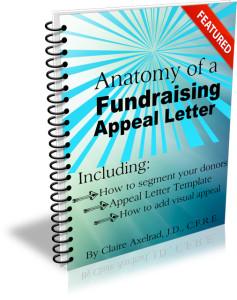 What’s the point of a fundraising appeal letter?
What’s the point of a fundraising appeal letter?
That’s obvious, right? To raise money!
But, wait a minute.
Dig deeper.
I always ask the question “why?” until I finally get to the end – where no more ‘why’ questions need to be asked — and uncover the true purpose behind anything I’m doing.
So… why are you endeavoring to raise money?
Because your organization needs contributed income.
Why does your organization need contributed income?
Because you don’t generate enough earned income to enact your mission.
Why don’t you generate enough earned income?
Because you make your services available for free or low cost to those who otherwise couldn’t afford them.
Why can’t folks afford what you offer without subsidy?
Because they’re … elderly on fixed incomes… vulnerable children… newly arrived immigrants… low-income single parents… families living below poverty level… veterans… unemployed… homeless… devastated by a natural emergency or illness… saddled by debt… or otherwise at-risk, marginalized, overlooked or being in need of a break.
Why else do you need community support?
Because the upfront cost is greater than the market will bear, but worth it for the ultimate community good of… a cure for a terminal disease… relief from devastating pain… ending injustice… saving the environment… preventing violence, abuse, addiction, suicide… restoring faith and inspiration to those whose lives would otherwise lack meaning, fulfillment and hope.
Aha! Now that you’ve answered all these important “why” questions you know the point of your fundraising appeal letter or email. Right?
It’s to get people to understand the benefit of their gift; what will happen absent their generosity.
It’s more than ridding themselves of the dollar they had burning in their pocket.
But wait another minute.
Can you dig still deeper?
Why do you want people to understand the outcome they can create?
Because… you want them to feel and act like a hero!
The purpose of a fundraising appeal is to get people to ACT.
And not just any old action.
You want folks to act heroically.
- Those appeals with no outright ask, and just the passive “hope you will support us?”
- Those appeals claiming “any donation, no matter how small, will help?”
Pish tosh.
Do you really want to engender feelings of having made a ‘drop in the bucket?’
If you ask folks to pee in the ocean to raise its level, you’re unlikely to reach that goal. And it feels overwhelmingly hopeless to your prospective donor.
If you ask for a gift of any size, or take folks to a landing page where $10 is an option, yet they know you have a $5 million budget, they’re likely to feel their donation won’t much matter to you.
How do you get people to act as if their gift is truly a lifesaver?
ACTION TIP:
— Articulate a monetary fundraising goal linked to a specific desired outcome.
— Place your ask within a context where it appears realistic enough to generate sufficient contributions to make that outcome a reality. If you ask me for $500 towards a $10,000 goal to help each of 20 at-risk women with specific, articulated services, I can visualize my gift going to work directly in a meaningful way.
The purpose of a fundraising appeal is to call for the action you desire.
What about beginning with the call to action?
That’s right.
And it’s the right way to write!
When you make your call to action an afterthought, you pretty much dig your own grave. You’ll get some responses, but not anywhere near the volume or amount you’d have received if you’d planned more thoughtfully.
ACTION TIP:
Rather than writing your letter first, write the response device.
—For a direct mail appeal letter it’s a printed remit piece (insert card, tear-off attachment or fold-over envelope). With direct mail you always want to be sure the reply device language and branding matches that of the appeal letter. What better way to assure you’re incorporating your SMIT (single most important thing) in your response mechanism than to craft it first?
— For an email appeal it’s a donate button and link to a donation landing page and donation form. With online appeals you always want to be sure the landing page to which folks are directed matches the email appeal that brought them there. When you consider crafting this page first, you generally realize you need a dedicated page that differs from your generic landing page. It’s good to know this from the get-go, rather than run out of time and decide you’ll just ‘make do’ with the page you’ve got.
The purpose of a fundraising appeal is to tell a story.
The body of your appeal screams out for a story. Sure, you can simply ask for money to cover your operations. And your most loyal donors will continue to give to you. However, you can do better. Much better! Especially if you want to attract new donors and upgraded gifts.
The essence of effective fundraising is purposeful storytelling. Your job is to develop a story (to me, this is the true meaning of the nonprofit term ‘development’) that is so compelling it inspires others to join in and become part of the narrative.
In fact, you want to persuade would-be donors to be the hero who gives your story its happy ending.
Begin by finding your story. Go talk to the folks who have the most interaction with those who benefit from your programs and services. Learn how your organization made a real difference in people’s lives. It’s easy for fundraisers to find themselves disconnected from the mission. You need to make a conscious effort to connect.
ACTION TIP:
Stay far, far away from clinical, process-based recitations of facts. The information may be factually correct, but it’s boring.
— Don’t ask program staff to send you a summary of their encounter with a beneficiary. When I worked in human services I soon learned I absolutely had to talk with care workers directly. Otherwise I was apt to receive a paragraph that looked something like this:
Middle aged woman presented with complaint she needed emergency rent assistance. Client was depressed and anxious due to care responsibilities for two small children and aging parent. Ex-husband had lost job and abandoned child care payments. Client also had issues with substance abuse. Reliable childcare was an issue; sometimes client left children home alone with grandmother when offered extra shifts she needed to make ends meet. Grandmother has mild dementia. Client now receiving financial aid and food vouchers and working with social worker to access benefits. Grandmother has been referred to senior services for evaluation. Referral also made to childcare program.
— Program staff may dwell on process over outcome; don’t you. Often I would find myself asking the clinician: “How did we really help? What was the improved outcome? Was there a happy ending? What help do they still need to improve their situation in a meaningful way? As the clinician talked, details began to emerge. More important than that, feelings and emotions were revealed. The clinician got excited whenever she could report a success. And sad when she could not.
The purpose of a fundraising appeal is feelings… nothing more than feelings…
How are you feeling about your story? Excited? Sad? If you don’t feel the emotion underlying your story your donor won’t either.
Feeling emotion is what triggers people to act.
We’re seeing a lot of genuine emotional stories today in the news. They’re extraordinarily powerful, because they’re not generic or clinical. They’re not generally about endemic racism, pandemic deaths or financial hardship. They’re specifically about one person and how they, their family and their community are hurting because of what happened. In learning about their truths, trials, tribulations and loss, all of us become connected to their story. And inspired to believe in new possibilities and a different vision for the future.
ACTION TIP:
Before sitting down to write your nonprofit’s story or stories, think about the stories currently inspiring you.
— Think about how these stories make you feel. On the verge of tears? Angry? Frustrated? Hopeful? Wanting to learn more? Ready to act?
— Challenge yourself to feel emotional about your subject matter before you begin to write your appeal.
— Then channel your emotion in a logical, credible way: Premise/problem. Conflict/obstacles to be overcome. Conflict escalation. Climax. Resolution/happy ending.
Master storyteller and copywriter Harvey McKinnon puts it this way:
“A good story has to have a number of qualities. First, it has to have emotion. Secondly, it needs to be real – we need to have something tangible happen. Stories have to come from a credible source – a mother talking about her child, someone who was homeless and who now has somewhere to live. Both of these scenarios are credible and understandable. Lastly, the notion that illustrates how the charity’s intervention makes the difference, thanks to a donor’s gift.”
Make your donors feel powerful emotions.
This is the purpose of your appeal.
The purpose of a fundraising appeal?
It’s too easy to lose sight of this critically important purpose.
Especially given the need you feel to implement and deliver.
- You’ve got a job to do, and “Write an appeal” is in your job description.
- Or it’s ‘that time of year.” Again.
- Or you’re trying to address an urgent situation, and your board is clamoring for you to send something out.
Don’t start with your what, when, where and how.
Begin with the why.
Why do you need contributions for this purpose?
Why would anyone else care?
Why is it important people feel the urgency of this matter?
Why will prospective donors’ feelings and purpose likely match your feelings and purpose?
Why will what you’re asking for resonate today?
Why haven’t past appeals been as successful as you would have wished?
Why are you preparing to send this particular appeal, to this particular group of people, right now?
Why will you be in a better position after this appeal is sent and received?
Why would it be unacceptable – to you and your supporters — not to reach this position?
The purpose of a fundraising appeal?
It’s so you don’t fail those who rely on you and your successful execution of your mission.
Failure is not an option.
Want to Learn More about Crafting Purposeful Appeals?
 Grab my Anatomy of a Fundraising Appeal + Sample Template. This is a simple, thorough, 62-page step-by-step guide to crafting a killer appeal letter or email appeal. It’s not just a breezy 2-page form, like what you’ll find elsewhere. Learn the art of taking your appeal from run of the mill to… out of the ballpark. From anesthetizing to… astounding. From colorless to… captivating. If you follow these guidelines, you’ll raise more money.
Grab my Anatomy of a Fundraising Appeal + Sample Template. This is a simple, thorough, 62-page step-by-step guide to crafting a killer appeal letter or email appeal. It’s not just a breezy 2-page form, like what you’ll find elsewhere. Learn the art of taking your appeal from run of the mill to… out of the ballpark. From anesthetizing to… astounding. From colorless to… captivating. If you follow these guidelines, you’ll raise more money.
Not happy? All Clairification products come with a no-questions-asked, 30-day, 100% refund guarantee. Honest!
Image with hopeful, purposeful message found on my walk, tacked to a tree.




